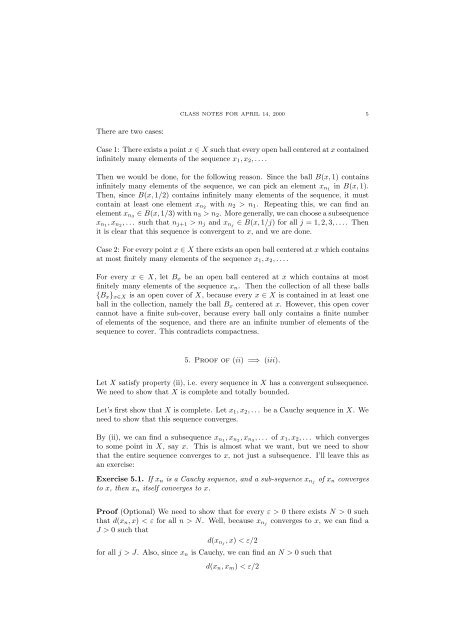Create successful ePaper yourself
Turn your PDF publications into a flip-book with our unique Google optimized e-Paper software.
There are two cases:<br />
CLASS NOTES FOR APRIL 14, 2000 5<br />
Case 1: There exists a point x ∈ X such that every open ball centered at x c<strong>on</strong>tained<br />
infinitely many elements of the sequence x1, x2, . . . .<br />
Then we would be d<strong>on</strong>e, for the following reas<strong>on</strong>. Since the ball B(x, 1) c<strong>on</strong>tains<br />
infinitely many elements of the sequence, we can pick an element xn1 in B(x, 1).<br />
Then, since B(x, 1/2) c<strong>on</strong>tains infinitely many elements of the sequence, it must<br />
c<strong>on</strong>tain at least <strong>on</strong>e element xn2 with n2 > n1. Repeating this, we can find an<br />
element xn3 ∈ B(x, 1/3) with n3 > n2. More generally, we can choose a subsequence<br />
xn1, xn2, . . . such that nj+1 > nj and xnj ∈ B(x, 1/j) for all j = 1, 2, 3, . . .. Then<br />
it is clear that this sequence is c<strong>on</strong>vergent to x, and we are d<strong>on</strong>e.<br />
Case 2: For every point x ∈ X there exists an open ball centered at x which c<strong>on</strong>tains<br />
at most finitely many elements of the sequence x1, x2, . . ..<br />
For every x ∈ X, let Bx be an open ball centered at x which c<strong>on</strong>tains at most<br />
finitely many elements of the sequence xn. Then the collecti<strong>on</strong> of all these balls<br />
{Bx}x∈X is an open cover of X, because every x ∈ X is c<strong>on</strong>tained in at least <strong>on</strong>e<br />
ball in the collecti<strong>on</strong>, namely the ball Bx centered at x. However, this open cover<br />
cannot have a finite sub-cover, because every ball <strong>on</strong>ly c<strong>on</strong>tains a finite number<br />
of elements of the sequence, and there are an infinite number of elements of the<br />
sequence to cover. This c<strong>on</strong>tradicts <strong>compact</strong>ness.<br />
5. Proof of (ii) =⇒ (iii).<br />
Let X satisfy property (ii), i.e. every sequence in X has a c<strong>on</strong>vergent subsequence.<br />
We need to show that X is complete and totally bounded.<br />
Let’s first show that X is complete. Let x1, x2, . . . be a Cauchy sequence in X. We<br />
need to show that this sequence c<strong>on</strong>verges.<br />
By (ii), we can find a subsequence xn1, xn2, xn3, . . . of x1, x2, . . . which c<strong>on</strong>verges<br />
to some point in X, say x. This is almost what we want, but we need to show<br />
that the entire sequence c<strong>on</strong>verges to x, not just a subsequence. I’ll leave this as<br />
an exercise:<br />
Exercise 5.1. If xn is a Cauchy sequence, and a sub-sequence xnj of xn c<strong>on</strong>verges<br />
to x, then xn itself c<strong>on</strong>verges to x.<br />
Proof (Opti<strong>on</strong>al) We need to show that for every ε > 0 there exists N > 0 such<br />
that d(xn, x) < ε for all n > N. Well, because xnj c<strong>on</strong>verges to x, we can find a<br />
J > 0 such that<br />
d(xnj, x) < ε/2<br />
for all j > J. Also, since xn is Cauchy, we can find an N > 0 such that<br />
d(xn, xm) < ε/2
















